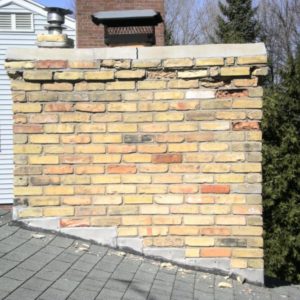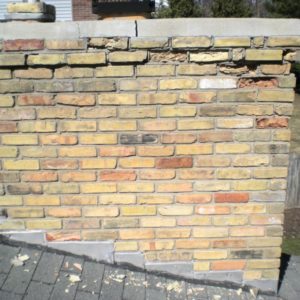I have a very severe chimney problem. While I cannot describe it I thought pictures might help. The chimney is not used for the furnace exhaust – I have an energy efficent furnace with PVC pipe to the outside at ground level. The only exhaust used is for a hot water heater but is enclosed in a stanless steel sleeve. There is a fireplace – unused and natural gas. Unused because my plasma screen TV covers the fireplace. Football is more important than romance!!
Can anyone tell me what in the world has happened to mky fireplace. I live in Michigan – very cold – and in suummer very humid. The destruction happens only in the winter. Thanks, Mike























Replies
Water is the culprit......
and damage in the winter when the water freezes, expanding damp brick, morter and the water entering lid.
Remove the damaged brick and probably rebuild the cap. Hang the cap out over the brick and caulk (urethane ) up under that cap.
Make sure you put in a removable expansion joint material around the flues. After forming the cap, place some cardboard (or something) around the flues, leave them up higher than what your cap will be. After / during pouring the cap, remove them so you can caulk in between the flues and the concrete cap. Provide slope to the cap to drain water.
Repoint all those cracks in the mortar (remove loose morter first).
Yep, it's frost damage -- water is getting into the brick/mortar, freezing, and forcing it apart.
You don't indicate how old this structure is, but a certain amount of this sort of deterioration is "normal" unless a chimney is agressively maintained, and it wouldn't be surprising to find a, say, 30-year-old chimney in this condition.
In any event, it needs to be fixed. The chimney needs to be taken down several courses to the point where it's solid, rebuilt, and then a new concrete cap poured (or stone cap installed). The existing cap (in addition to being cracked) is too narrow, not providing sufficient "shade" from the rain for the brick below, and this exacerbates the problem. But most of the damage is likely occurring because water is getting into the chimney through cracks in the cap and around the flues that penetrate the cap.
In the meantime you can slow the deterioration by caulking all the cracks in the cap.
I had the same situation, when I put in a direct vent furnace in 8 years ago and only had the water heater fed into the chimney, which is on the outside of the house like yours. The way it was explained to me is that the water heater puts out a small amount of hot flue gases compared to a furnace or fireplace. In the winter when those flue gases are going up that cold chimney, they cool off and condense on the walls of the chimney and cause the mortar around the bricks to fail. The flue liner was suppossed to prevent this problem, but my chimney looked like yours after 3 winters. I have recently replaced my water heater with a direct vent tank heater so that nothing is fed into the chimney anymore.
thanks
Thanks for all your responses. I had the cap repaired @3 years ago. Apparently I do not need to have that mason guy reappear. I was told he has forgotten more about chimmneys than I ever knew. True, but he must have forgotten caulk, extend the cap over the edge and fix the shattered bricks. Is this something a DIY with limited knowledge of cement and brick laying should even attempt?
I could replace the hot water heater - or as they say the cold water heater - with a pvc vent system but it works just fine - even though it is10+ years old.
Thoughts?
Sure you can.
http://www.maconline.org/tech/design/fireplace1/chimneyd/chimneyd.html
and be sure to look at the pdf in this one:
http://www.masonryconstruction.com/industry-news.asp?sectionID=0&articleID=245219
And this one, has pictures omitted but the verse is and important read.
http://findarticles.com/p/articles/mi_m0NTA/is_3_17/ai_n6094137/
Finally, insetting a grid of rebar the length of the cap with crossbars connecting on each side of the flue separations is a very good idea. This will help hold the thing together. Remember to isolate the flues themselves from the cap and caulk the gap.
Best of luck.